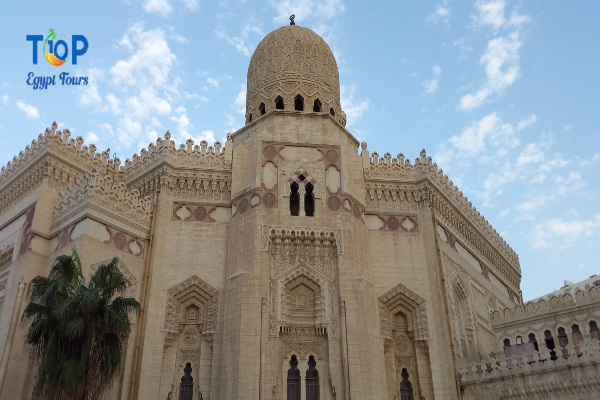Welcome to the enchanting world of Egypt, where history, culture, and architecture converge to create a tapestry of beauty. In the coastal city of Alexandria, a hidden gem awaits discovery – the Abu Abbas Mosque. This architectural masterpiece is a testament to the rich heritage of Egypt, seamlessly blending Islamic and Gothic influences. Join us on a virtual tour as we explore the intricate details and historical significance of this magnificent structure.
I. Historical Background:
Abu Abbas is Shihab al-Din Abu al-Abbas Ahmad bin Hassan bin Ali al-Khazraji al-Ansari al-Mursi. He was born in the city of Murcia in Andalusia in the year 616 AH, corresponding to 1219 AD, and from there he obtained his title, the Mursi.
Nestled amidst the bustling streets of Alexandria, Abu Abbas Mosque has a storied past that dates back centuries. Its foundations can be traced to the era when Islamic and Gothic architectural styles began to intertwine, giving birth to a unique fusion. The mosque stands as a symbol of the cultural diversity that has defined Egypt throughout its history.
II. Architecture Of Abu Abbas Mosque:
Islamic Influences:
The Abu Abbas Mosque’s Islamic architecture is evident in its geometric patterns, intricate calligraphy, and the iconic dome that graces its skyline. The design reflects the principles of Islamic art, emphasizing symmetry and a harmonious blend of form and function.
Gothic Inspirations:
What sets Abu Abbas Mosque apart is the infusion of Gothic elements into its structure. Pointed arches, ribbed vaults, and soaring spires are reminiscent of the Gothic cathedrals of Europe. This amalgamation of styles creates a visual spectacle that captures the imagination of all who behold it.
III. Symbolism and Design Elements:
Minarets: The minarets of Abu Abbas Mosque reach towards the heavens, symbolizing a connection between Earth and the divine.
Mihrab: The intricately designed mihrab serves as the focal point for prayer, adorned with Arabic calligraphy and geometric patterns.
Stained Glass Windows: Gothic-inspired stained glass windows bathe the interior in a kaleidoscope of colors, adding a touch of mystique to the sacred space.
IV. Cultural Significance:
Abu Abbas Mosque stands as a living testament to the blending of cultures and religions. It serves as a place of worship, cultural exchange, and a reminder of the interconnected history of civilizations that have left their mark on Egypt.
V. Visitor Experience:
As you step into the courtyard of Abu Abbas Mosque, the scent of incense and the soothing sounds of prayer create a serene atmosphere. Visitors are encouraged to explore the intricate details of the architecture, participate in guided tours, and witness the mosque’s role in fostering intercultural understanding.
In the heart of Alexandria, the Abu Abbas Mosque beckons travelers to immerse themselves in a world where Islamic and Gothic architecture unite in perfect harmony. This sacred space not only serves as a place of worship but also stands as a testament to the enduring spirit of cultural exchange that defines Egypt. Come, discover the fusion of traditions at Abu Abbas Mosque, a jewel in the crown of Egypt’s architectural treasures.



Comment (0)